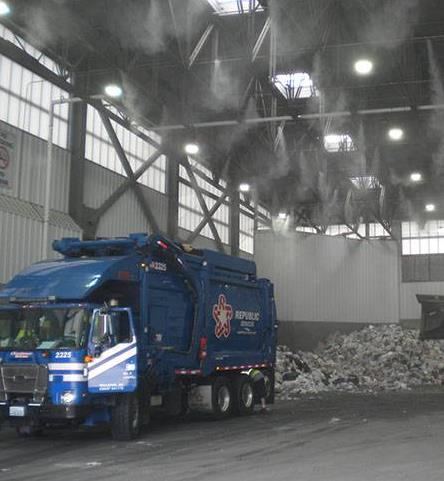
There are three typical flue gas absorption and purification processes for waste incineration flue gas: semi-dry spray drying, dry flue gas purification and wet flue gas washing. These processes have their own characteristics. Among them, the semi-dry spray drying method of pollutant removal efficiency between the dry method and the wet method, with simple system, low investment and operating costs, no waste water and other advantages, is a very promising process, at present in the domestic waste incineration plant flue gas purification system more and more applications.
The semi-dry spray drying purification process often takes Ca (OH) 2 slurry as the absorbent, atomizes it into 50 ~ 150μm droplets with the nozzle, and fully mixes with the waste incineration flue gas, and absorbs the acidic gas while the droplets evaporate and dry.
Spray drying purification process is a very complex flow, heat, mass transfer and chemical reaction process, and many aspects of its mechanism have not been well understood and understood.
In recent decades, with the increasingly mature theory of multiphase flow and the rapid development of computer technology, people try to use mathematical simulation to study the spray drying process in order to improve the removal efficiency of pollutants and reduce operating costs.

1. Heat transfer and evaporation
The removal efficiency of pollutants in spray drying process is closely related to the evaporation drying process of alkaline droplets. The droplet drying is too fast, and the removal efficiency of pollutants decreases sharply. The droplet drying is too slow, and the outlet of the spray dryer is still wet, which will affect the normal work of the subsequent equipment. It is very important to study the heat transfer and evaporation process of spray drying to improve the removal efficiency of pollutants.2.1 Mechanism of heat transfer and evaporation
The mechanism of the whole spray drying process is: after the alkaline droplets leave the atomizer, they are mixed with hot flue gas in the drying room, and the heat and mass exchange occurs simultaneously in the boundary layer of the two. There are many factors affecting the heat and mass transfer between the droplet and the flue gas, including the temperature and flow state of the flue gas, the size of the droplet and the concentration of the absorbent, the residence time of the droplet in the dryer, etc. For the convenience of analysis, the following assumptions are made in the paper:1) The droplet is spherical;
2) The heat of reaction and heat of solution are very small and can be ignored;
3) Water does not circulate inside the droplet;
4) Acid gas and water vapor are diffused at the same time, and water evaporation and acid gas absorption do not affect each other.
The constant heat and mass exchange between the alkaline droplet and the flue gas in the process of spray drying can be expressed by Nu Schaert number and Sh Sherwood number, respectively. Considering the characteristics of wind field flow and particle movement in the drying tower, the heat transfer in the whole drying process can be considered as forced convection heat transfer, and the factors affecting the heat transfer coefficient are all included in the relevant dimensionless frequency group (criterion number). For spherical fog, the heat transfer of the process can be expressed by the Lanz-Marshall relation.
3 Conclusion
1) The evaporation and drying process of liquid droplets is very complicated, which is divided into four stages in this paper, and the calculation formulas of heat and mass transfer in each stage are obtained.2) The ionic reaction is instantaneous in the liquid phase, but relatively slow in the case of water shortage, and the evaporation of water in the alkaline droplet directly affects the removal of acidic gas.
3) There are many factors affecting the removal efficiency of acid gas, among which stoichiometric ratio and near adiabatic saturation temperature of outlet gas are two main factors. When there is HCl gas in the flue gas, the absorption of SO2 gas will be affected.


